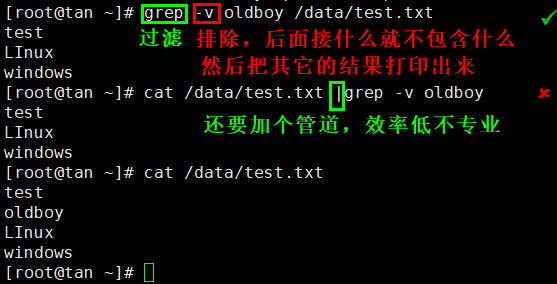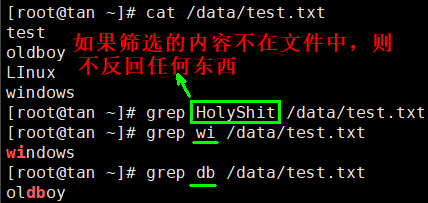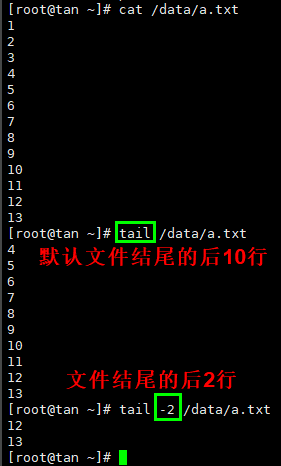grep、head和tail
一、请给出打印test.txt内容时,不包含oldboy字符串的命令






Linux系统中grep命令是一种强大的文本搜索工具,它能使用正则表达式搜索文本,并把匹 配的行打印出来。grep全称是Global Regular Expression Print,表示全局正则表达式版本,它的使用权限是所有用户。 grep的工作方式是这样的,它在一个或多个文件中搜索字符串模板。如果模板包括空格,则必须被引用,模板后的所有字符串被看作文件名。搜索的结果被送到标准输出,不影响原文件内容。 grep可用于shell脚本,因为grep通过返回一个状态值来说明搜索的状态,如果模板搜索成功,则返回0,如果搜索不成功,则返回1,如果搜索的文件不存在,则返回2。我们利用这些返回值就可进行一些自动化的文本处理工作。 1.命令格式: grep [option] pattern file 2.命令功能: 用于过滤/搜索的特定字符。可使用正则表达式能多种命令配合使用,使用上十分灵活。 3.命令参数: -a --text #不要忽略二进制的数据。 -A<显示行数> --after-context=<显示行数> #除了显示符合范本样式的那一列之外,并显示该行之后的内容。 -b --byte-offset #在显示符合样式的那一行之前,标示出该行第一个字符的编号。 -B<显示行数> --before-context=<显示行数> #除了显示符合样式的那一行之外,并显示该行之前的内容。 -c --count #计算符合样式的列数。 -C<显示行数> --context=<显示行数>或-<显示行数> #除了显示符合样式的那一行之外,并显示该行之前后的内容。 -d <动作> --directories=<动作> #当指定要查找的是目录而非文件时,必须使用这项参数,否则grep指令将回报信息并停止动作。 -e<范本样式> --regexp=<范本样式> #指定字符串做为查找文件内容的样式。 -E --extended-regexp #将样式为延伸的普通表示法来使用。 -f<规则文件> --file=<规则文件> #指定规则文件,其内容含有一个或多个规则样式,让grep查找符合规则条件的文件内容,格式为每行一个规则样式。 -F --fixed-regexp #将样式视为固定字符串的列表。 -G --basic-regexp #将样式视为普通的表示法来使用。 -h --no-filename #在显示符合样式的那一行之前,不标示该行所属的文件名称。 -H --with-filename #在显示符合样式的那一行之前,表示该行所属的文件名称。 -i --ignore-case #忽略字符大小写的差别。 -l --file-with-matches #列出文件内容符合指定的样式的文件名称。 -L --files-without-match #列出文件内容不符合指定的样式的文件名称。 -n --line-number #在显示符合样式的那一行之前,标示出该行的列数编号。 -q --quiet或--silent #不显示任何信息。 -r --recursive #此参数的效果和指定“-d recurse”参数相同。 -s --no-messages #不显示错误信息。 -v --revert-match #显示不包含匹配文本的所有行。 -V --version #显示版本信息。 -w --word-regexp #只显示全字符合的列。 -x --line-regexp #只显示全列符合的列。 -y #此参数的效果和指定“-i”参数相同。 4.规则表达式: grep的规则表达式: ^ #锚定行的开始 如:'^grep'匹配所有以grep开头的行。 $ #锚定行的结束 如:'grep$'匹配所有以grep结尾的行。 . #匹配一个非换行符的字符 如:'gr.p'匹配gr后接一个任意字符,然后是p。 * #匹配零个或多个先前字符 如:'*grep'匹配所有一个或多个空格后紧跟grep的行。 .* #一起用代表任意字符。 [] #匹配一个指定范围内的字符,如'[Gg]rep'匹配Grep和grep。 [^] #匹配一个不在指定范围内的字符,如:'[^A-FH-Z]rep'匹配不包含A-R和T-Z的一个字母开头,紧跟rep的行。 \(..\) #标记匹配字符,如'\(love\)',love被标记为1。 \< #锚定单词的开始,如:'\<grep'匹配包含以grep开头的单词的行。 \> #锚定单词的结束,如'grep\>'匹配包含以grep结尾的单词的行。 x\{m\} #重复字符x,m次,如:'0\{5\}'匹配包含5个o的行。 x\{m,\} #重复字符x,至少m次,如:'o\{5,\}'匹配至少有5个o的行。 x\{m,n\} #重复字符x,至少m次,不多于n次,如:'o\{5,10\}'匹配5--10个o的行。 \w #匹配文字和数字字符,也就是[A-Za-z0-9],如:'G\w*p'匹配以G后跟零个或多个文字或数字字符,然后是p。 \W #\w的反置形式,匹配一个或多个非单词字符,如点号句号等。 \b #单词锁定符,如: '\bgrep\b'只匹配grep。 POSIX字符: 为了在不同国家的字符编码中保持一至,POSIX(The Portable Operating System Interface)增加了特殊的字符类,如[:alnum:]是[A-Za-z0-9]的另一个写法。要把它们放到[]号内才能成为正则表达式,如[A- Za-z0-9]或[[:alnum:]]。在linux下的grep除fgrep外,都支持POSIX的字符类。 [:alnum:] #文字数字字符 [:alpha:] #文字字符 [:digit:] #数字字符 [:graph:] #非空字符(非空格、控制字符) [:lower:] #小写字符 [:cntrl:] #控制字符 [:print:] #非空字符(包括空格) [:punct:] #标点符号 [:space:] #所有空白字符(新行,空格,制表符) [:upper:] #大写字符 [:xdigit:] #十六进制数字(0-9,a-f,A-F) 5.使用实例: 实例1:查找指定进程 命令: ps -ef|grep svn 输出: [root@localhost ~]# ps -ef|grep svn root 4943 1 0 Dec05 ? 00:00:00 svnserve -d -r /opt/svndata/grape/ root 16867 16838 0 19:53 pts/0 00:00:00 grep svn [root@localhost ~]# 说明: 第一条记录是查找出的进程;第二条结果是grep进程本身,并非真正要找的进程。 实例2:查找指定进程个数 命令: ps -ef|grep svn -c ps -ef|grep -c svn 输出: [root@localhost ~]# ps -ef|grep svn -c 2 [root@localhost ~]# ps -ef|grep -c svn 2 [root@localhost ~]# 说明: 实例3:从文件中读取关键词进行搜索 命令: cat test.txt | grep -f test2.txt 输出: [root@localhost test]# cat test.txt hnlinux peida.cnblogs.com ubuntu ubuntu linux redhat Redhat linuxmint [root@localhost test]# cat test2.txt linux Redhat [root@localhost test]# cat test.txt | grep -f test2.txt hnlinux ubuntu linux Redhat linuxmint [root@localhost test]# 说明: 输出test.txt文件中含有从test2.txt文件中读取出的关键词的内容行 实例3:从文件中读取关键词进行搜索 且显示行号 命令: cat test.txt | grep -nf test2.txt 输出: [root@localhost test]# cat test.txt hnlinux peida.cnblogs.com ubuntu ubuntu linux redhat Redhat linuxmint [root@localhost test]# cat test2.txt linux Redhat [root@localhost test]# cat test.txt | grep -nf test2.txt 1:hnlinux 4:ubuntu linux 6:Redhat 7:linuxmint [root@localhost test]# 说明: 输出test.txt文件中含有从test2.txt文件中读取出的关键词的内容行,并显示每一行的行号 实例5:从文件中查找关键词 命令: grep 'linux' test.txt 输出: [root@localhost test]# grep 'linux' test.txt hnlinux ubuntu linux linuxmint [root@localhost test]# grep -n 'linux' test.txt 1:hnlinux 4:ubuntu linux 7:linuxmint [root@localhost test]# 说明: 实例6:从多个文件中查找关键词 命令: grep 'linux' test.txt test2.txt 输出: [root@localhost test]# grep -n 'linux' test.txt test2.txt test.txt:1:hnlinux test.txt:4:ubuntu linux test.txt:7:linuxmint test2.txt:1:linux [root@localhost test]# grep 'linux' test.txt test2.txt test.txt:hnlinux test.txt:ubuntu linux test.txt:linuxmint test2.txt:linux [root@localhost test]# 说明: 多文件时,输出查询到的信息内容行时,会把文件的命名在行最前面输出并且加上":"作为标示符 实例7:grep不显示本身进程 命令: ps aux|grep \[s]sh ps aux | grep ssh | grep -v "grep" 输出: [root@localhost test]# ps aux|grep ssh root 2720 0.0 0.0 62656 1212 ? Ss Nov02 0:00 /usr/sbin/sshd root 16834 0.0 0.0 88088 3288 ? Ss 19:53 0:00 sshd: root@pts/0 root 16901 0.0 0.0 61180 764 pts/0 S+ 20:31 0:00 grep ssh [root@localhost test]# ps aux|grep \[s]sh] [root@localhost test]# ps aux|grep \[s]sh root 2720 0.0 0.0 62656 1212 ? Ss Nov02 0:00 /usr/sbin/sshd root 16834 0.0 0.0 88088 3288 ? Ss 19:53 0:00 sshd: root@pts/0 [root@localhost test]# ps aux | grep ssh | grep -v "grep" root 2720 0.0 0.0 62656 1212 ? Ss Nov02 0:00 /usr/sbin/sshd root 16834 0.0 0.0 88088 3288 ? Ss 19:53 0:00 sshd: root@pts/0 说明: 实例8:找出已u开头的行内容 命令: cat test.txt |grep ^u 输出: [root@localhost test]# cat test.txt |grep ^u ubuntu ubuntu linux [root@localhost test]# 说明: 实例9:输出非u开头的行内容 命令: cat test.txt |grep ^[^u] 输出: [root@localhost test]# cat test.txt |grep ^[^u] hnlinux peida.cnblogs.com redhat Redhat linuxmint [root@localhost test]# 说明: 实例10:输出以hat结尾的行内容 命令: cat test.txt |grep hat$ 输出: [root@localhost test]# cat test.txt |grep hat$ redhat Redhat [root@localhost test]# 说明: 实例11:输出ip地址 命令: ifconfig eth0|grep -E "([0-9]{1,3}\.){3}[0-9]" 输出: [root@localhost test]# ifconfig eth0|grep "[0-9]\{1,3\}\.[0-9]\{1,3\}\.[0-9]\{1,3\}\.[0-9]\{1,3\}" inet addr:192.168.120.204 Bcast:192.168.120.255 Mask:255.255.255.0 [root@localhost test]# ifconfig eth0|grep -E "([0-9]{1,3}\.){3}[0-9]" inet addr:192.168.120.204 Bcast:192.168.120.255 Mask:255.255.255.0 [root@localhost test]# 说明: 实例12:显示包含ed或者at字符的内容行 命令: cat test.txt |grep -E "ed|at" 输出: [root@localhost test]# cat test.txt |grep -E "peida|com" peida.cnblogs.com [root@localhost test]# cat test.txt |grep -E "ed|at" redhat Redhat [root@localhost test]# 说明: 实例13:显示当前目录下面以.txt 结尾的文件中的所有包含每个字符串至少有7个连续小写字符的字符串的行 命令: grep '[a-z]\{7\}' *.txt 输出: [root@localhost test]# grep '[a-z]\{7\}' *.txt test.txt:hnlinux test.txt:peida.cnblogs.com test.txt:linuxmint [root@localhost test]# 实例14:日志文件过大,不好查看,我们要从中查看自己想要的内容,或者得到同一类数据,比如说没有404日志信息的 命令: grep '.' access1.log|grep -Ev '404' > access2.log grep '.' access1.log|grep -Ev '(404|/photo/|/css/)' > access2.log grep '.' access1.log|grep -E '404' > access2.log 输出: [root@localhost test]# grep “.”access1.log|grep -Ev “404” > access2.log 说明:上面3句命令前面两句是在当前目录下对access1.log文件进行查找,找到那些不包含404的行,把它们放到access2.log中,后面去掉’v’,即是把有404的行放入access2.log
posted on 2019-03-31 17:10 Holy_Shit 阅读(2680) 评论(0) 编辑 收藏 举报
